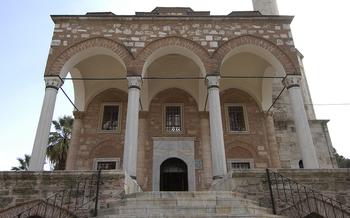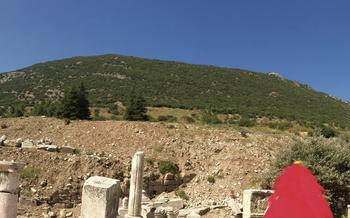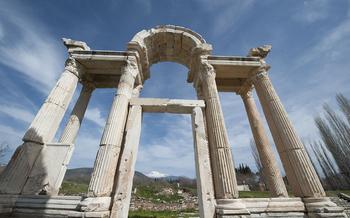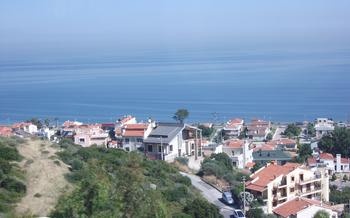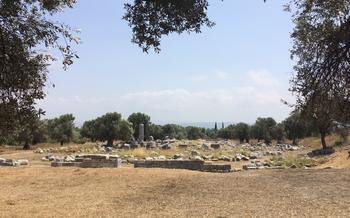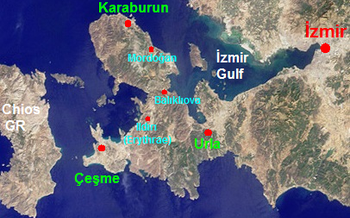
Magnesia Ancient City
- Historical Background
- Main Attractions
- Temple of Artemis: A Marvel of the Ancient World
- Agora
- Theater
- City Walls and Gates
- Residential Areas
- Local Cuisine:
- Festivals and Events
- Outdoor Activities:
- Accommodation
- Insider Tip: Discovering the Hidden Gem of Magnesia
Historical Background
Magnesia, an ancient city located in the Aydın province of Turkey, boasts a rich and diverse history that spans several millennia. Founded by the Magnesians, an Ionian tribe, in the 6th century BC, the city quickly rose to prominence as a cultural and economic center. Its strategic location at the intersection of trade routes between the Aegean Sea and the Anatolian hinterland contributed to its growth and prosperity.
Over the centuries, Magnesia came under the influence of various civilizations, each leaving its mark on the city's architecture, culture, and traditions. The Persians, Greeks, Romans, and Byzantines all ruled the city at different times, and their respective influences can be seen in the city's ruins and artifacts. Notable historical figures associated with Magnesia include the philosopher Thales of Miletus, who was born in the city, and the Roman emperor Hadrian, who visited the city and contributed to its development.
Main Attractions
Temple of Artemis:
The Temple of Artemis, one of the Seven Wonders of the Ancient World, is a must-see attraction within the ancient city of Magnesia. Built in the 6th century BC, this colossal temple was dedicated to the Greek goddess Artemis, known as the protector of nature and hunting. The temple's grandeur is evident in its impressive size, measuring approximately 135 meters in length and 68 meters in width. Its massive columns, intricate carvings, and exquisite architectural details are a testament to the skill and artistry of the ancient Greeks.
Agora:
The Agora, or marketplace, was the central hub of ancient Magnesia, serving as a bustling center for trade, social gatherings, and political activities. Surrounded by colonnaded walkways, the Agora was a vibrant space where merchants displayed their goods, citizens engaged in lively debates, and officials conducted public affairs. Visitors can still admire the well-preserved ruins of shops, public buildings, and a bouleuterion, where the city council met.
Theater:
The Theater of Magnesia is an impressive structure that could accommodate up to 20,000 spectators. Built in the 2nd century BC, the theater hosted various performances, including plays, concerts, and religious ceremonies. Its excellent acoustics and stage design allowed for clear sound and visual effects, ensuring an immersive experience for the audience. Visitors can marvel at the theater's well-preserved seating tiers, stage area, and intricate architectural details.
Temple of Artemis: A Marvel of the Ancient World
Among the many architectural wonders of Magnesia, the Temple of Artemis stands as a testament to the city's cultural significance and artistic prowess. Constructed in the 6th century BC, this magnificent structure was dedicated to the Greek goddess Artemis, who was revered as the protector of nature, childbirth, and hunting. The temple's grandeur and architectural sophistication earned it a place among the Seven Wonders of the Ancient World, alongside iconic structures like the Pyramids of Giza and the Hanging Gardens of Babylon.
The Temple of Artemis was not just a religious edifice but also a symbol of Magnesia's wealth and power. Its construction required immense resources and skilled craftsmanship, and its design showcased the city's mastery of architecture and engineering. The temple's massive columns, intricately carved friezes, and impressive size continue to awe visitors to this day.
According to mythology, the temple was built on the site where Artemis was born, and it became a popular pilgrimage destination for worshippers from across the ancient world. The temple's fame and sanctity attracted numerous visitors, contributing to Magnesia's status as a major religious and cultural center.
Throughout its history, the Temple of Artemis faced several challenges, including natural disasters and invasions. It was destroyed by an earthquake in the 4th century BC but was later rebuilt with even greater splendor. However, its final demise came at the hands of the Goths in the 3rd century AD, who razed the temple to the ground.
Despite its destruction, the legacy of the Temple of Artemis lives on. Its ruins, which include fragments of columns, friezes, and sculptures, offer a glimpse into the architectural brilliance of the ancient Magnesians. The temple's enduring significance as one of the Seven Wonders of the Ancient World ensures that its memory will continue to inspire and captivate generations to come.
Agora
The Agora, the bustling heart of ancient Magnesia, served as the city's central marketplace and social gathering place. This vibrant public space, with its colonnaded walkways, shops, and public spaces, was a hub of activity and commerce.
Imagine the lively atmosphere as merchants displayed their wares, shoppers haggled over prices, and locals gathered to exchange news and gossip. The Agora was not just a place of trade but also a center of civic life, where political meetings, religious ceremonies, and festivals took place.
As you stroll through the Agora's well-preserved ruins, you can almost hear the echoes of laughter, chatter, and the clinking of coins. The architectural features, such as the Doric columns, intricate friezes, and mosaic floors, speak to the grandeur and importance of this ancient marketplace.
Ongoing restoration efforts aim to breathe new life into the Agora, allowing visitors to experience its former glory. Take a moment to sit on one of the stone benches, close your eyes, and let your imagination transport you back in time to the bustling days of ancient Magnesia.
Theater
The theater, with its imposing presence, is an architectural marvel that captivates visitors with its grandeur and historical significance. Built to accommodate thousands of spectators, this magnificent structure was the epicenter of entertainment and cultural events in ancient Magnesia.
The theater's design is a testament to the skilled craftsmanship of its builders. Its expansive seating area, divided into tiers, ensured excellent sightlines for all patrons. The stage, adorned with intricate carvings and sculptures, provided a platform for a variety of performances, including plays, concerts, and religious rituals.
The acoustics of the theater were meticulously engineered, allowing for crystal-clear sound projection throughout the auditorium. This acoustic excellence made it possible for actors and performers to captivate their audience with their voices and expressions.
Beyond its architectural prowess, the theater holds a wealth of stories and legends. It is said that renowned playwrights and actors graced its stage, mesmerizing audiences with their performances. The theater also served as a venue for political gatherings and religious ceremonies, adding to its multifaceted role in the ancient city.
For those seeking a truly immersive experience, attending a performance or event in the Magnesia theater is a must. Even today, the theater occasionally hosts concerts and cultural events, allowing visitors to step back in time and experience the magic of this ancient venue.
City Walls and Gates
The city walls of Magnesia stand as a testament to the city's strategic importance and defensive prowess. Constructed from massive blocks of stone, the walls enclosed the city, providing protection from invaders and serving as a boundary marker. The walls were meticulously engineered, featuring a complex system of gates and towers that allowed for controlled access to the city.
The gates of Magnesia were not merely functional entrances but also architectural masterpieces. Each gate had its own unique design, reflecting the city's cultural and artistic heritage. The Main Gate, for example, was adorned with intricate carvings and sculptures, showcasing the skill and artistry of Magnesia's craftsmen.
The walls and gates of Magnesia not only served a defensive purpose but also played a significant role in the daily lives of the city's inhabitants. They regulated the flow of goods and people, providing a sense of security and order within the city. The gates were also used for public gatherings and announcements, serving as a central point of communication for the community.
As you explore the ruins of Magnesia, take a moment to appreciate the grandeur and significance of the city walls and gates. These impressive structures have stood the test of time, silently narrating tales of battles fought, alliances forged, and the resilience of a city that refused to be conquered.
Residential Areas
A Glimpse into Ancient Daily Life
Step into the well-preserved residential areas of Magnesia and journey back in time to experience the daily lives of its ancient inhabitants. These neighborhoods, with their intricate layouts and diverse architectural features, offer a fascinating glimpse into the social structure and domestic life of this once-thriving city.
Explore the typical houses, each with its own unique character. Admire the spacious courtyards, where families gathered for meals, relaxation, and household chores. Discover the well-appointed rooms, designed for specific purposes such as cooking, dining, sleeping, and storage.
Imagine the hustle and bustle of daily life as residents went about their routines. Artisans crafted their wares in workshops, merchants traded goods in the Agora, and families tended to their homes and hearths. The streets echoed with laughter, conversation, and the sounds of everyday life.
Through archaeological findings, we can piece together the social structure of ancient Magnesia. Extended families likely lived together in large households, with each member playing a specific role. Children attended school, learning essential skills for their future roles in society.
As you wander through these ancient neighborhoods, let your imagination run wild. Picture the residents going about their daily tasks, celebrating festivals, and creating a vibrant community. These well-preserved ruins breathe life into the past, allowing us to connect with the people who once called Magnesia home.
Local Cuisine:
Savor the culinary delights of Aydın and the surrounding region, where Turkish and Aegean traditions blend harmoniously to create tantalizing dishes. Indulge in keşkek, a hearty wheat and meat stew, or relish the flavors of zeytinyağlı yaprak sarması, delicate vine leaves stuffed with rice, herbs, and pine nuts, cooked in olive oil. For a sweet treat, try incir tatlısı, a delectable dessert made from fresh figs, walnuts, and honey syrup.
Discover the authentic flavors of Aydın's local cuisine at traditional Turkish restaurants and cafes. Ask the locals for their recommendations and venture into the heart of the city to find hidden gems serving mouthwatering dishes. Enjoy the vibrant atmosphere of the local markets, where you can purchase fresh produce, spices, and sweets to create your own culinary masterpieces.
Immerse yourself in the culinary journey of Aydın and savor the region's rich flavors, a harmonious blend of tradition and innovation.
Festivals and Events
Aydın comes alive with a vibrant calendar of festivals and events throughout the year, offering visitors a chance to immerse themselves in the local culture and traditions. One of the most popular events is the Aydın Grape and Wine Festival, held annually in September. This lively festival celebrates the region's rich viticulture and features wine tasting, grape stomping competitions, and traditional music and dance performances.
For those interested in history and archaeology, the Magnesia Cultural Festival is a must-attend event. Held in the ancient city of Magnesia itself, this festival showcases the region's rich cultural heritage through exhibitions, workshops, and guided tours of the ancient ruins.
If you're visiting Aydın in the summer, don't miss the Aydın International Art Festival. This month-long festival features a diverse range of art forms, including painting, sculpture, photography, and theater, showcased in various venues across the city.
For a unique and authentic experience, join the locals at the weekly Aydın Farmers Market. Held every Sunday in the city center, this bustling market offers a wide variety of fresh produce, handmade crafts, and local delicacies.
No matter what time of year you visit, there's always something exciting happening in Aydın. Check out the local tourism office or online event listings for up-to-date information on festivals and events during your stay.
Outdoor Activities:
Venture beyond the ancient city walls and explore the natural wonders of the Aydın region. Lace up your hiking boots and embark on a journey through scenic mountain trails, lush forests, and breathtaking coastal paths. Adrenaline enthusiasts can cycle along winding roads, surrounded by picturesque landscapes. Birdwatching enthusiasts will delight in the diverse avian species that call this region home. Embrace the tranquility of nature as you immerse yourself in the beauty of the Aydın countryside.
Whether you're an avid hiker, cyclist, or simply seeking a serene escape, the Aydın region offers an array of outdoor activities that will invigorate your senses and leave you feeling refreshed and revitalized.
Accommodation
Aydın offers a diverse range of accommodation options to suit every budget and preference. From budget-friendly hostels and guesthouses to comfortable hotels and luxurious resorts, there's something for every traveler. For those seeking a budget-friendly option, there are several hostels and guesthouses located in the city center, offering basic amenities and a social atmosphere. Mid-range hotels provide a comfortable stay with modern amenities, while luxury hotels offer upscale accommodations, stunning views, and a range of amenities such as spas, pools, and fine dining.
When choosing a hotel, consider your budget, location preferences, and desired amenities. If you're on a tight budget, hostels and guesthouses are a great option. For those who prefer a more comfortable stay, mid-range hotels offer a good balance of value and amenities. For a truly luxurious experience, splurge on a stay at one of the city's top-rated hotels, which offer exceptional service, stunning views, and a host of amenities.
To ensure a smooth and hassle-free stay, it's advisable to book your accommodation in advance, especially during peak tourist season. Online booking platforms and travel agents can help you find the best deals and compare prices across different hotels.
Insider Tip: Discovering the Hidden Gem of Magnesia
Beyond the iconic ruins and historical landmarks, Magnesia holds a secret gem waiting to be discovered. Nestled amidst the picturesque countryside, just a short drive from the ancient city, lies the enchanting village of Söke. This charming village offers a glimpse into the region's rich cultural heritage and provides a tranquil escape from the bustling city.
Stroll through the cobblestone streets of Söke and admire the traditional Turkish houses, each adorned with colorful flowers and intricate carvings. Visit the local bazaar to experience the vibrant atmosphere and shop for authentic souvenirs and fresh produce.
Don't miss the opportunity to savor the village's culinary delights. Indulge in traditional Turkish cuisine at one of the many cozy restaurants, where you can taste mouthwatering dishes prepared with fresh, local ingredients.
Take a break from history and immerse yourself in the natural beauty of the surrounding landscapes. Hike through the lush forests, cycle along scenic trails, or simply relax on the shores of the nearby lake.
Söke is a true hidden gem that offers a unique blend of history, culture, and natural wonders. Whether you're seeking a peaceful retreat or an adventurous escape, this charming village is sure to captivate your senses and leave you with lasting memories.
